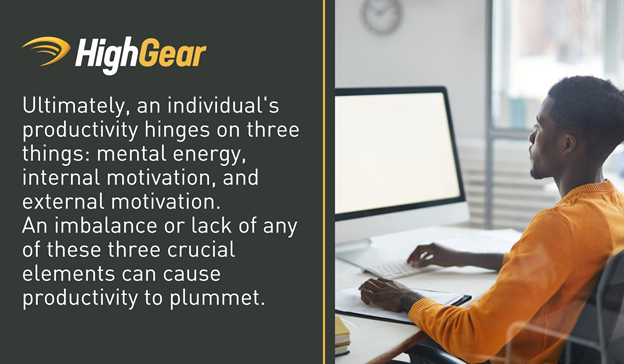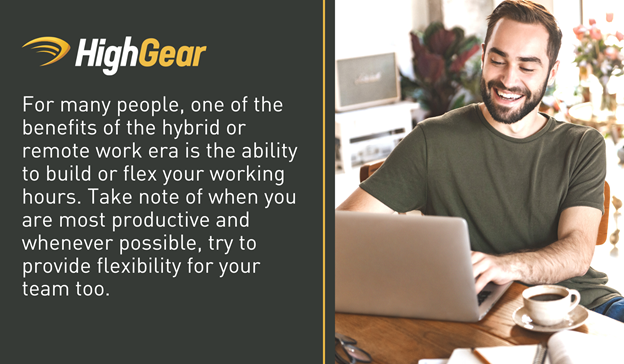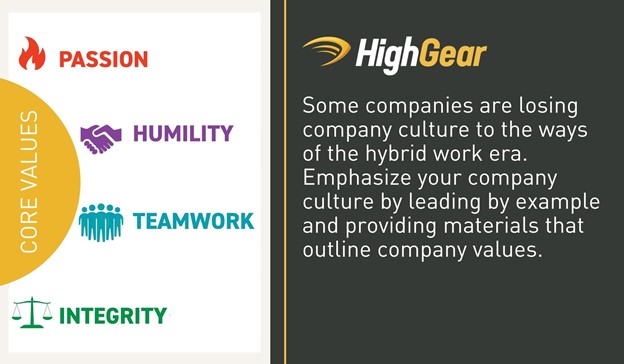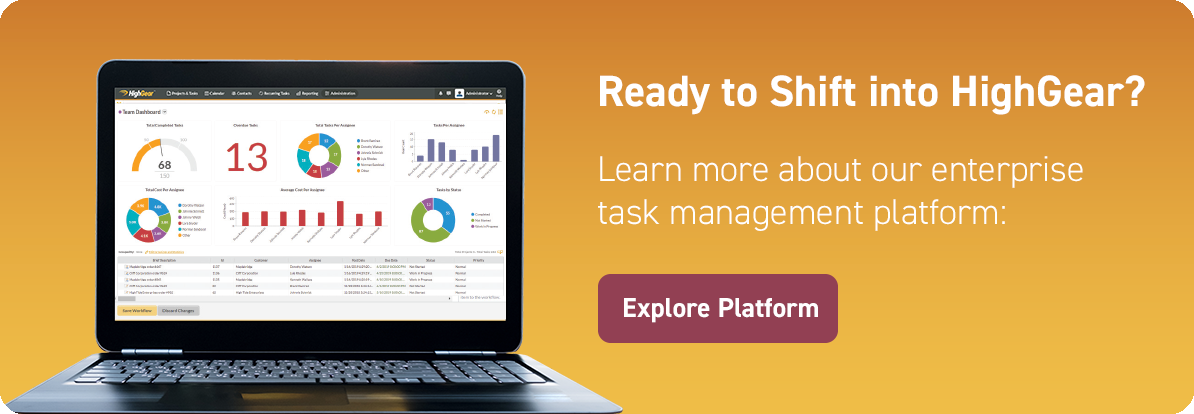
Defining Productivity
The definition of what it means to be productive or the standard for productivity can differ from person to person. Generally speaking, we know productivity to mean an individual, team, or organization’s ability to work efficiently within a given time to maximize output. On an individual basis, one person may view productivity as getting more done within a single day, whereas another person views it as getting everything on your plate done as quickly as possible so you have the largest amount of free time remaining.
What Influences One’s Productivity?

Ultimately, an individual’s productivity hinges on three things: mental energy, internal motivation, and external motivation. An imbalance or lack of any of these three crucial elements can cause productivity to plummet. Take, for example, the person who views work as a necessary but unfulfilling part of the day. Their “get it over with” mentality may take them so far, but if their internal motivation is low, their resulting productivity will be too.
On the other hand, someone who enjoys and finds fulfillment in work might try to get as much done as possible within a given time and maximize their productivity. The trouble is that work is not their only priority; they have children to feed, meals to cook, hobbies to catch up on, and extracurricular activities to attend. In this latter case, a lack of mental energy may slow them down.
Managers need to be made aware of these three factors and take into account that each team member must balance all three in order to have the most productive outputs. Mental energy, internal motivation, and external motivation can all be influenced by a number of different factors as well. Personality, experience, and work structure also influence a person and ultimately a team’s productivity. Certain personality traits like conscientiousness and planfulness (one’s tendency to develop detailed plans) are theorized to be strong predictors of productivity, for example. Other personality traits like the need to be in control, whether theorized or actual, can make a person more or less productive depending on their role.
Conversely, Psychology Today says that “A person who struggles with time management, has lower self-control, or is high in perfectionism may be more likely to procrastinate than others. Some researchers also hypothesize that individuals high in both neuroticism and extraversion may be more likely to procrastinate than those who are lower in the two traits, since neurotic extroverts may be prone to experiencing the intense negative emotions that can make procrastination more likely.”
Brian Tracy’s 10 Rules to Master Productivity
“Lack of clarity is the number-one time-waster. Always be asking, ‘What am I trying to do? How am I trying to do it?” – Brian Tracy
Brian Tracy has studied, researched, written, and spoken for 30 years on topics such as time management, productivity, public speaking, and goal setting. He has acted as a consultant and mentor to more than 1,000 companies and addressed more than 5,000,000 people in 5,000 talks and seminars. Needless to say, he is an expert in productivity.
Through his decades of research and experience, Brian crafted 10 specific skills and tips to help anyone master productivity. Not only can you as an employee benefit from studying and implementing these rules, but they may be helpful to share with your team. These rules, or more accurately guidelines, are easy to implement but have a huge impact. The ten rules are:
1. Utilize the “one-touch” rule: The “touch it once” rule follows a simple plan: complete a task or project in one sitting from start to finish instead of starting and stopping and bouncing between different projects. Let the emails collect in your mailbox (they’re not going anywhere) and close the tabs that don’t relate to the job at hand. Ultimately, even if they are work tasks, they are distractions.

2. Write it down: The mind can be a messy place. Whether it’s in a journal, notebook, or calendar, or formalized work management system, write down your to-dos big and small and savor the moment of slashing through each line item. This will be your go-to to keep you on track and measure your progress rather than swimming in your thoughts.
3. Set small goals: Just like traits such as perfectionism can cause you to procrastinate and dwell on every last detail, setting goals that are too lofty can cause inaction. Slice big projects up into easy-to-digest pieces to celebrate small victories and chip away at a bigger project bit by bit (or bite by byte!)
4. Plan ahead: Utilize your to-do list to have clear direction before you start each morning.
5. Avoid over-committing: Take note of your most productive days, what types of tasks you did, and how you felt during and after the workday. Realize your limits and respect them by not overcommitting and weighing yourself down with the weight of unfinished work.
6. Stop multitasking: Multitasking is out, no matter what the job description says. Studies have found that multitasking makes 97.5% of people less productive than if they choose one project and stick with it.
7. Start the hardest task first: Want to take a bite out of your to-do list and keep the productivity flowing? Get the hardest task done first. Tim Ferriss, author of The 4-Hour WorkWeek echoes this sentiment.

8. Determine when you are most productive: For many people, one of the benefits of the hybrid or remote work era is the ability to build or flex your working hours. Take note of when you are most productive and whenever possible, try to provide flexibility for your team too. Consider how the home/office has changed for your team and the roles that have been added to their working days and how this affects their mental energy and productivity.
9. Eliminate disruptions: Whether you are working from home or in the office, try to create a space that fosters productivity and eliminates distractions and disruptions. Sometimes it means adding distance between you and your phone, turning off notifications on email for an hour, or even moving to a quiet secluded room in the home instead of the dining room table. Allow yourself the mental headspace and physical space to be truly productive and free from disruptions.
10. Set time limits: Deadlines are a powerful motivator, especially when self-imposed. Check out this sharable and downloadable “infographic” on how to set effective time limits and use the Focus Booster app to become more productive.
How to help your team understand what makes them productive
In addition to sharing the above expert tips on becoming one’s most productive self, managers need to take into account the basic premise of the Person-Environment fit theory. This theory states that for each individual, there are physical environments that are most compatible with their characteristics. Achieving the correct “fit” may result in reduced stress, improved mood, and heightened productivity.
This theory, and understanding the personal characteristics that an individual has and seeks in a work environment, underlies the advice in all of the “tips to be more productive while WFH” blogs. The desire for control or lack thereof may dictate how productive a person is in certain environments. A worker who desires control may prefer structured work environments such as a cubicle over working from home with children and/or a spouse. The PwC’s US Remote Work Survey conducted in 2021 found that there still is no consensus among workers regarding the optimal balance of workdays at home vs. in the office.
To help your employees create their own productive mindsets and environments, keep these tips in mind:
-
- Provide learning opportunities: According to a study by the National Center for Education Statistics, one of the most reliable ways to increase employee productivity is to provide educational opportunities.
-
- Increase employee engagement: In a global research done by Gallup, team members with higher levels of engagement produce significantly better outcomes and are more likely to stay within their organization than those who are less engaged. Here is a link to Raconteur’s cheat sheet with statistics from Gallup and other data sources on ways to boost workplace productivity: https://www.raconteur.net/infographics/7-ways-to-boost-workplace-productivity/.

-
- Emphasize company culture: Some companies are losing company culture to the ways of the hybrid work era. Emphasize your company culture by leading by example and providing materials that outline company values.
- Set clear goals: Setting and communicating clear and achievable goals for yourself and each member of your team is crucial for productive and high-quality work. When describing the project, communicate clearly and leave room for questions. Make sure to set aside time to reconnect and ask if any problems have come up or if they have lost direction after they’ve begun working. Collaboration capabilities in work management software can really support a more productive environment.
- Empower employees with technology: Without the proper tools, projects can get lost in notebooks and “mind files” rather than reaching each member of the team. Zoom calls, although helpful, won’t cut it. Use a workflow automation software to increase information flow, clearly outline tasks, and track the progress of projects in a way that’s visible to every member of the team.
Productivity and motivation can be hard to get a handle on. In order for the team to succeed and produce their most productive outcomes, mental energy, internal motivation, and external motivation must be in harmony for each individual on the team. This can be challenging for managers to uphold especially as the workforce becomes more physically distanced. However, with the right tools, managers and their teams can be empowered to understand what drivers make them more productive and what they can do to maximize their time.
References:
1. https://www.ottawa.edu/online-and-evening/blog/december-2020/ways-to-increase-employee-productivity-in-2021
2. https://www.pwc.com/us/en/library/covid-19/us-remote-work-survey.html
3. https://www.psychologytoday.com/us/basics/productivity
4. https://health.clevelandclinic.org/science-clear-multitasking-doesnt-work/
5. http://psychology.iresearchnet.com/industrial-organizational-psychology/recruitment/person-environment-fit/
6. https://www.gallup.com/workplace/284180/factors-driving-record-high-employee-engagement.aspx
7. https://www.raconteur.net/infographics/7-ways-to-boost-workplace-productivity/

